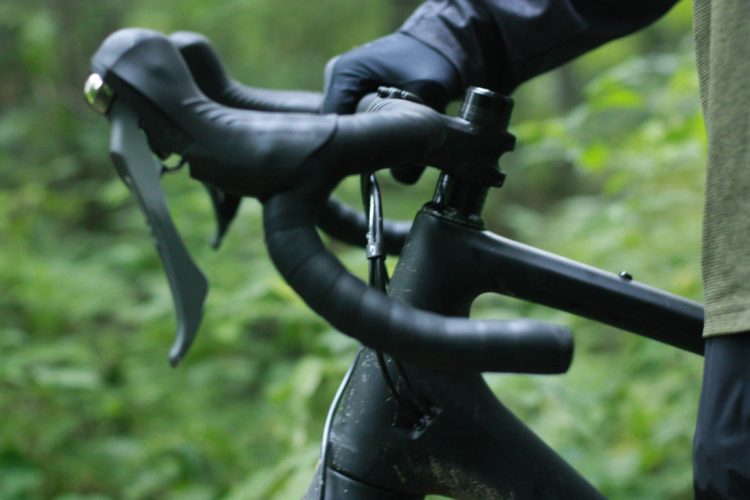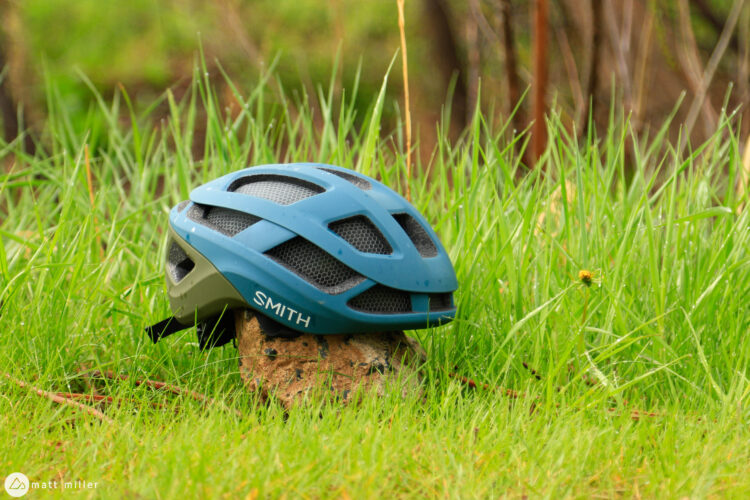One cool thing that has taken the mountain bike world by storm is the use of video cameras on the trail. GoPro, one of the original action sports helmet camera companies, has really stepped up once again with the new GoPro HD Helmet HERO. At $299 MSRP you’re looking at a good value with all the features and accessories you need included in the box. Here’s what you get: the video camera (5 megapixel) with 1100mAh Li-Ion battery, protective case with a fully enclosed waterproof backing and a vented back plate (perfect for MTB), 6 mounts (2 flat adhesive, 2 curved adhesive, one headlamp style and one for a vented helmet), a pivot hinge to angle the Hero just right off your helmet or bike, 1 component cable (HDTV), 1 composite video cable + audio, and a USB cable. Phew!
Before you start filming you’ll need to prep the camera and get a few items in order. First off, get yourself the highest class SDHC card you can find. This is important and isn’t stressed enough in the manual. The memory card class rating will directly affect the performance of your camera. GoPro recommends at least Class 4 media but I have found that Class 8 works the best; the GoPro HD accepts memory cards up to 32GB. After you get a memory card, install the battery and charge the camera fully before using. In my tests a full charge took 4 hours to complete via the USB connection.
It’s a good thing the battery takes 4 hours to charge – that was about how much time I needed to get comfortable with the controls and menus on the GoPro. The GoPro utilizes a two button control system but depending on how long you press them, buttons will either change from one mode to the next or change up a setting. You really need to read the owners manual that is supplied but don’t fret if you lose it – the manual is available online as well.
I recommend playing with the menus and settings to find which of the five video and two exposure settings work best. Remember the higher the resolution or frames per second (FPS), the quicker the GoPro eats up memory. As an example, at maximum resolution and 30 FPS, an 8GB card will give you less than an hour of recording time.
Once you get the hang of using the GoPro you get decent video and nice 5MP photos. In video mode there are 5 format choices: WVGA @ 60FPS (low res, fast action), 720p @ 30FPS (medium res, regular speed), 720p @ 60FPS (medium res, enhanced for slow motion), 960p @ 30FPS (high res, regular speed), and finally the highest resolution of 1080p @ 30FPS (full HD, 127-degree field of vision). I opted to do most of my shooting in standard 960p mode and tried 720p @ 30FPS for longer sessions. In the settings menu (something I didn’t use often) you can also choose how the camera shoots (single shot, triple shot, shot every X seconds, and timer). This is great if you want to snap pics of the trail automatically without having to stop periodically to click the camera.
On the trails I found the best way to avoid Blare Witch style footage is to mount the camera on the helmet. Initially I tried clamping the handlebar mount to the seat post and frame but found the playback a little too jerky.
The two control buttons are easy enough to get use with gloves on, but remembering which button to press is another story when the camera is on top of your head. It also takes some trial and error to set the camera at the correct angle when shooting at 720p but at 960p it’s not a real issue.
When traveling fast through dark brush and into bright clearings I found the GoPro HD takes a second or two to adjust to the lighting conditions so I enabled spot metering and that really helped. I also changed over to the vented backing and found that it improved sound quality tremendously. The GoPro HD recorded what I was saying along with the sounds of the trail without a ton of wind noise. After crashing more than once I’m pleased to say the camera doesn’t show any signs of damage.
Now the GoPro does not come with video editing software so this is where it’s up to you to choose what you want to use. With the proper software you can edit in slow motion, clear up shakiness, change exposure levels, and much more. Basic video software like Windows Live Movie Maker or Final Cut will allow you to clip and arrange the video plus add titles, photos, and music. Do yourself a favor though and only get as much software as you need. You don’t have to spend your hard-earned money on features that you will never use plus expensive programs add to the complexity of video editing.
I would have to say for a go-anywhere adventure video camera that includes everything you need, the GoPro HD is the one to buy. The GoPro website also has additional accessories to make that perfect shot possible!
Specs from GoPro
Camera Optics
* Lens Type: Fixed Focus (2ft/.6m – ?), glass
* Aperture: f/2.8 (high performance in low-light situations)
* Angle of View: 170 ultra wide angle in WVGA, 720p, or 960p mode
* Angle of View: 127 wide angle in 1080p mode
Video
* HD Video Resolution Modes: (subject to change, pending final firmware release)
o 1080p = 1920×1080 pixels (16:9), 30 fps, 15 Mbit/s data rate
o 960p = 1280×960 pixels (4:3), 30 fps, 12 Mbit/s data rate
o 720p = 1280×720 pixels (16:9), 60 fps, 15 Mbit/s data rate
o 720p = 1280×720 pixels (16:9), 30 fps, 8 Mbit/s data rate
o WVGA = 848×480 pixels (16:9), 60 fps, 8 Mbit/s data rate
* Sensor Type: 1/2.5″ HD CMOS, 2.2m-sized pixels
* Light Sensitivity: Super low-light sensitivity (>1.4 V/lux-sec)
* Video Format: H.264 compression, saved as Windows- & Mac-compatible MPEG4 (.mp4) file
* Exposure Control: Auto with user selectable center weighted average and spot metering settings
* White Balance: Auto
Audio
* Microphone: Built-in, mono with AGC (automatic gain control)
* Audio Format: 48 kHz, AAC audio compression
Photo
* Resolution: 5 megapixel
* Capture Modes: Single shot, photo every 2, 5, 10, 30 or 60 secs.; 3 photo burst; self-timer
Storage
* Memory: SD card, up to 32GB capacity (SDHC)
* Average recording times (using 32GB SD card):
o 1080p (30 fps): 4h 21m
o 960p (30 fps): 5h 26m
o 720p (60 fps): 4h 21
o 720p (30 fps): 8h 09m
o WVGA (60 fps): 8h 09m
Power & Battery
* Battery Type: Rechargeable 1100 mAh lithium-ion
* Battery Life: Approx. 2.5 hrs
* Charging: via USB to computer or optional power adapter
* Charge Time: 80% capacity after 1 hour with optional power adapter; or 2 hours with a computer’s USB port
Waterproof Camera Housing
* Depth Rating: Up to 180 feet / 60 meters
* Construction: Polycarbonate and stainless steel
* Hardware: Stainless steel
Size & Weight
* Dimensions (H x W x D): 1.6″ x 2.4″ x 1.2″ (42mm x 60mm x 30mm)
* Weight: 3.3oz (94g) incl. battery, 5.9oz (167g) incl. housing
I would like to thanks the folks at GoPro for providing the HD Helmet HERO for a review.























3 Comments
Jul 26, 2010
Jul 21, 2010
May 27, 2011